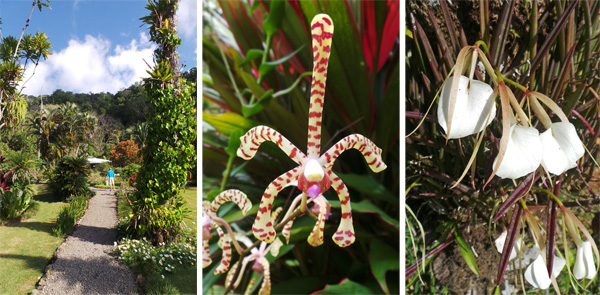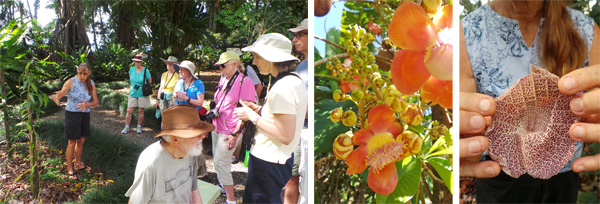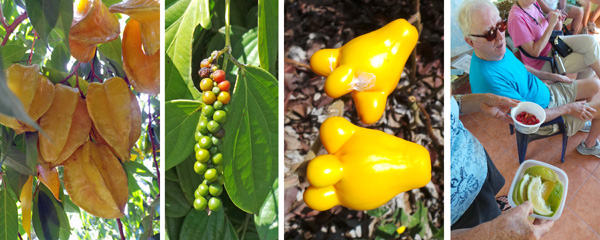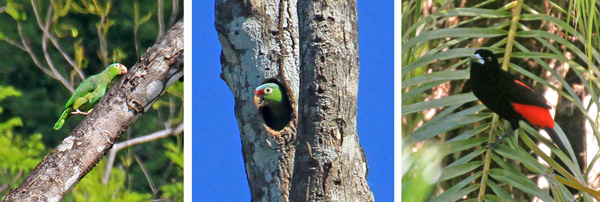Just about the only downside to being in such a remote location was the lack of TV (and until a few months ago, internet access; we found out Sunday morning that they DO have internet now; their website needs to be updated). Fortunately the fact that it was Super Bowl Sunday didn’t even come up until lunch time and no one was particularly concerned that we would miss the big game (but with a large contingent of Wisconsin residents on the this trip, I can’t imagine what we’d have done if the Green Bay Packers had been playing…maybe have to take a boat and then a taxi to get to a bar in Golfito to watch the game?). Without much connection to the outside world, this time was an opportunity to focus on something other than screens, and appreciate the incredible natural world around us.
Because our journey from the mountains to the resort was delayed several hours because of road construction, we didn’t have time to visit Casa Orquideas on our arrival day as planned, so instead made that excursion the following day when we didn’t have anything planned. Only a 5 minute boat ride away from where we were staying, this private botanical garden that was developed in the 1970’s is surrounded on three sides by primary rainforest, and includes tropical fruit trees, bromeliads, cycads, palms, heliconias, ornamental plants and more than 100 varieties of orchids. The unexpected part of the visit was the wet landing, as the boats just drove up in the surf and we had to jump out into the shallow water and wade up the beach. Most of us were not prepared for that and had to take off our boots or tennis shoes first (and do the same on the return) – making it even more of an adventure!
Approaching the shore at Casa Orquideas (L); on the gravelly beach after the wet landing (C); near the entrance to the botanical garden (R).
We were fortunate to have owner Trudy escort us around part of the extensive property, telling us about some of the many interesting plants here. First she shared the history of the place, then we wandered the paths, stopping here and there to learn about some medicinal plants, got to taste or smell spices and edible plants, were shown beautiful orchids and bloom, and saw a number of interesting endemic and exotic plants that are grown there.
One of the main paths in the garden (L); Scorpion orchid (horticultural type) (C); Brassavola nodosa, a fragrant orchid (R).
Trudy tells the group about vanilla (L); flowers of cannonball tree, Couroupita guianensis (C); and Trudy holding open calico flower, a species of Aristsolochia.
Star fruit, Averrhoa carambola(L); peppercorns, Piper nigrum (LC); poisonous fruits of Solanum mammosum, used medicinally for congestion (RC); and Trudy distributing lemons and miracle fruit (Synsepalum dulciferum) which changes the taste of anything from sour to sweet – which we got to test (and it does work) (R).
That left Gustavo free to look for birds, and set up his spotting scope so the group could see a variety of birds including red-lored parrot, white hawk, Cherrie’s tanager, and many others.
After our visit at the botanic garden, we returned to the lodge in the humid air. The rest of the day was free for everyone to do as they chose: take a dip in the warm, calm waters of the Gulf, wander the rainforest trails on the property, or lounge in a hammock. A few of us joined Gustavo on a late afternoon hike along the trails into the native rainforest on the property, stopping frequently to investigate whatever plant, bird, or insect we happened to notice. With his wealth of knowledge, Gustavo had an interesting story to accompany almost everything we saw, adding greatly to the learning experience. With so many species, it wasn’t easy to know what everything was (especially the insects), so many of them we had to just appreciate them for their beauty or bizarre appearance.
Out on the rainforest trail (L); a blooming Passiflora high up in the canopy (LC); a buttressed tree trunk (RC); a large, flat millipede (R).
Raffia palm, with fronds up to 15 feet long (L); pretty orange gesneriad flower (LC); a monkey grasshopper (Eumastax sp.), only half inch wide, with legs spread out perpendicular to the body (RC); a male brown basalisk (R).
Golden orb weaver spiders (small male and large female) (L); galls on a leaf (LC); a bronze-colored cerambycid beetle (RC); Passiflora coccinea (R).








